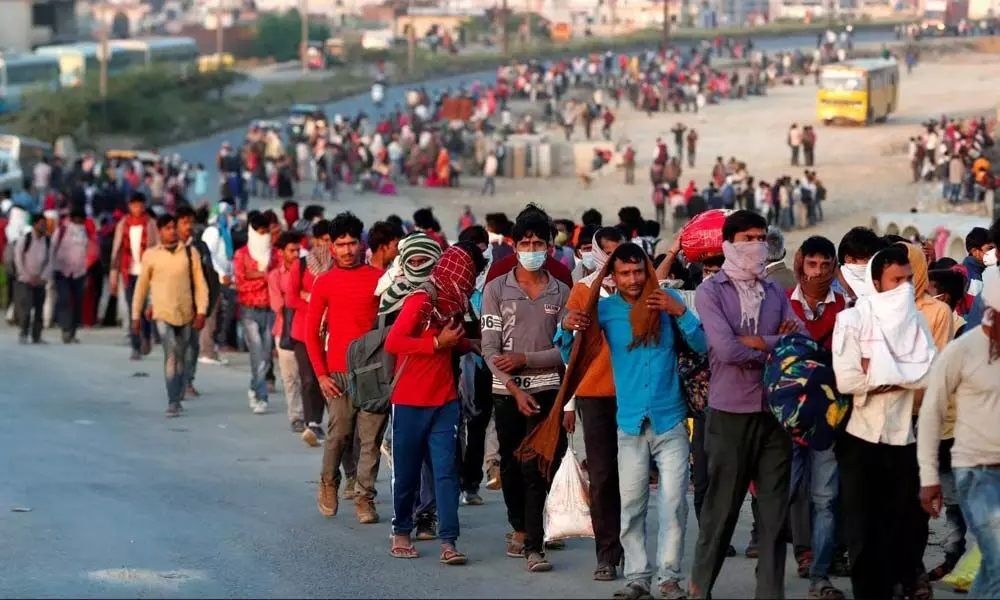RTI#15: Government clueless on migrant labour

RTI#15: Government clueless on migrant labour
If right information is not given at the right time, it could cause death
If right information is not given at the right time, it could cause death. Lack of knowledge about existence of migrant labour led the Union government to declare lockdown without making any arrangement of food or travel for workless workers moving back to homes on foot. Lack of plans and information about food and travel resulted in several deaths either in accidents or of exhaustion.
The first and foremost crisis the nation confronted was crores of migrant labour moving from one place to another after sudden imposition of nation-wide lockdown from midnight, as announced by the Prime Minister over television on March 24, at 8pm. The government gave people just four hours to prepare themselves. It also triggered a humanitarian crisis of an unprecedented scale. For months followed, thousands of migrant workers, who were rendered jobless overnight due to the lockdown and had no means to survive in cities in absence of wages, started moving towards their villages, on heals or wheels, whatever they could find. The lockdown implemented in India was considered the strictest in the world.
The tragedy was that the government failed to gauge the issue of people working at different places and failed to provide any relief to them, because they had no information about it.
The corona-caused lockdown turned out to be information lock-down with 28 State Information Commissions were on Covid-19 vacation shutting down the doors. The Central Information Commission took at least a few hearings on WhatsApp platform connecting both the parties from the residence of the Commissioner with skeleton office support. The CHRI could ascertain the fact of closure of SICs in 28 States while CIC could function from April 20.
For a few months, citizens had no benefit of first or second appeals, without which they cannot even approach the High Courts under writ jurisdiction. Similarly, the legal remedy for police excesses and violations of human rights were not within the reach as the subordinate judiciary has been totally ceased from functioning while High Courts and Supreme court had a few hearings through video conference of 'emergency' matters. Besides information, the justice also was mostly inaccessible.
Venkatesh Nayak, of CHRI has tried to secure the information about the migrant workers and their conditions during Covid-19 from Central Labour Commissioner's (CLC) office. Disappointed with the CLC, he filed a complaint with the Central Information Commissioner, which rightly took up out of turn hearing. But the CIC chose to give an advisory to the Chief Labour Commissioner, requiring him to upload information about stranded workers on an official website within a week's time. It was not a direction. The CLC has a statutory duty under section 4 of RTI Act to voluntarily disclose the data about migrant labour and its efforts to find solution to their crisis of survival and transport. The tragedy is this section is rarely implemented and the law, nodal agencies and the Information Commission have no clue on breach of Section 4.
The CLC had, on April 8, issued a circular to his regional heads to collect data about every stranded migrant worker in every district and State. Templates were issued for data capture during the enumeration process. Both blue- and white-collared workers were to be enumerated in this manner. The regional heads were given three days to collect this data and send it to the CLC. This shows inefficiency and defective governance in CLC.
According to the Chief Labour Commissioner's office, the three States that recorded highest number of migrant workers who are stranded are Chhattisgarh (10,85,828), Kerala (2,86,846) and Telangana (1,84,006). The total number of stranded migrant workers is 26,17,218 and most of them (46%) are in localities where they are usually 'clustered'. 43% are stranded within their workplaces and only a tiny minuscule 10% are staying in actual relief camps or shelter homes.
There are several news reports about tragedies of migrant workers being killed in various kinds of accidents. There are some such gruesome instances: a) May 16 in Auraiya, Uttar Pradesh, 27 migrant workers were killed and 33 injured when a trailer truck carrying sacks of lime and 43 people rammed into a stationary truck with a number of migrant workers sitting inside it near a roadside eatery. b) May 8, a goods train in Maharashtra's Aurangabad crushed and ran over 16 migrant workers, who fell asleep on tracks due to exhaustion, while walking towards their home in Madhya Pradesh. c) April 21: 12-year-old Jamlo Makdam died of exhaustion and dehydration after walking for nearly 110 kms from Telangana to her village in Chhattisgarh's Bijapur district. She had gone to Telangana to work in the chilli fields. d) May 27: In Bihar's Muzaffarpur a toddler was trying to wake his dead mother lying unattended on a railway platform. The woman was travelling in a Shramik Special train from Ahmedabad and was headed to Katihar. There are several such incidents, where government was expected to provide some help to the victims.
According to a media report, the database maintained voluntarily by four individuals has recorded 906 deaths between March 14 and July 4, 2020 and classified them under 10 categories. As per the data available on thejeshgn.com, the highest number of 216 deaths between March 14 and July 4 occurred due to the combined reasons of starvation and loss of money, 209 deaths took place due to road or train accidents and 133 suicides were also reported during lockdown. The database showed that 77 persons died due to lack or denial of medical care, 49 of them lost their lives because of alcohol withdrawal, 47 people had died of exhaustion, either due to the walk home or because of standing in long queues, while 49 migrants died in quarantine centres, and 18 succumbed to non-communal, lockdown-associated crimes. During the lockdown, 12 persons lost their lives in police excessive actions.
In the last week of May, the cause of 238 migrant workers being killed in various accidents was analysed. The reasons for migrant workers' deaths include: getting burnt to death in forest fires, being hit or crushed by truck/bus/trains, exhaustion, heart attack, blood in vomiting, chest pain, asphyxiation after falling in a deep pit, being trapped in snow, stomach pain, breathlessness, hunger, exhaustion, dehydration, fatigue, multi-organ failure, and snake bite, among others. The government did not care to find out these causes and provide relief. It did not even hesitate to declare that it does not know.
To a Parliament question whether it was collecting or collating data on the number of workers of the unorganised sector, contract workers and labourers in the country, the government answered: "no such proposal is under consideration".
The CLC stated that a little more than 26 lakh migrant workers remain stranded across India and most of them are either in relief camps or at their workplaces. Journalist Akshay Deshmani of Huffington Post brought out the contradictions of the 'data', saying: "In a press conference in mid-May, Finance Minister Nirmala Sitharaman estimated the number of migrant workers stranded across India after announcement of lockdown to be eight crores. Further, the Narendra Modi government's lawyers informed the Supreme Court in the last week of May that the administration sent 97 lakh migrant workers home between May 1 and 27. While 50 lakh migrant workers were sent home via Shramik special trains, the remaining 41 lakh were sent through road transportation".
Bangladesh's newspaper 'Financial Express' wrote on June 14, that the scenario has also gained additional dimensions because of emerging facets resulting out of measures being adopted to try and control the growing after-effects and impact of the Covid-19 on stranded migrant workers. This last aspect drew the attention of the world with reference to India. Oxygen of information is missing in hospitals, government, and democracy.
(The writer is Dean, School of Law, Bennett University, and former Central Information Commissioner)














